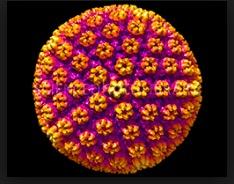If you ever need a reminder about how difficult it is to discover new drugs or vaccines, here it is. Despite 100 years (!) of research we still don't have a vaccine for herpes simplex (1,2).
There is now another failed herpes vaccines, but this time it's not bad news for genital herpes sufferers. Vical, a California-based biotech, announced that its vaccine for cytomegalovirus (CMV) doesn't work and will be dropped. But, what does this have to do with herpes?
Most people know very little about CMV (3). Although the virus, is not a problem for most of us, it can cause very serious infections for people with compromised immune systems, especially transplant patients. CMV has another name: Human herpesvirus-5 (HHV5). It is one of nine known herpesviruses that infect people. Here are the others:
- HSV-1 is also called human herpesvirus 1 (HHV1) causes oral and genital herpes
- HSV-2 (HHV2) causes genital herpes
- HHV3 is better known as the varicella-zoster virus (VZV). It causes chicken pox and shingles.
- HHV4 is better known as the Epstein-Barr virus. It causes mononucleosis.
- HHV5 is CMV
- HHV6 is actually a family of two different viruses, HHV6A and HHV6B. They are not well-understood
- HHV7 is also poorly understood.
- HHV8 is the cause of Kaposi's sarcoma, which was a rare skin cancer until AIDS came along.
In 2011 Vical teamed up with the Japanese pharmaceutical company Astellas Pharma Inc. to develop a potential CMV vaccine (formerly TransVax™) called ASP0113. Trials started in 2013, but the vaccine ran into a snag in 2106. ASP0113 was supposed to reduce CMV infections in kidney transplant patients. It did not.
But the company persevered. At the time ASP0113 was being evaluated in a phase III (5) trial called HELIOS for protection against CMV infection in patients who had undergone bone marrow transplants. Perseverance is usually an admirable quality.
“We are pleased with our collaborative relationship with Astellas, and we look forward to the results from the pivotal Phase III study in HCT (hematopoietic cell transplant aka bone marrow transplant) recipients, which we expect to obtain during the fourth quarter of 2017.”
Vical CEO Vijay Samant. September 19, 2016
He spoke too soon. Astellas and Vical just announced the results of the HELIOS trial. No so good.
"We are disappointed that the results did not demonstrate a significant improvement in overall survival and reduction in CMV end-organ disease."
Bernhardt G. Zeiher, president of Development, Astellas. January 22, 2018
The companies deserve credit for trying, but history was not on their side. Going back 100 years we have only 2 vaccines that work to prevent infection against exactly 1 of the 9 human herpesviruses - the varicella-zoster virus also known as human herpesvirus-3 (HHV3) aka VZV, which causes shingles and chickenpox. (When VZV infects children the virus causes chickenpox. When it emerges later in life in people who previously had chickenpox (usually as children) it is called shingles, but it's the same bug.)
The two vaccines against VZV are redundant. One of them Zostavax, (Merck), is a live attenuated vaccine which received FDA approval in 2006 for prevention of shingles in adults who are 50 or older. The other, Shingrix (GlaxoSmithKline), is a sub-unit (synthetic) vaccine which was recently approved, also for adults 50 and older. Shingrix is the preferred vaccine. Expect Zostavax to go bye-bye.
According to the CDC, 99% of Americans (40 and older) have had chickenpox (7). Although these vaccines should prevent chicken pox, this is not how they will be used. Kids already have a chickenpox vaccine.
As do other herpesviruses, the varicella-zoster (chickenpox) virus hides in a nerve root of people who had the infection as a child. Then, when you least want it (which is always) it can erupt from the root and cause an outbreak of shingles, which not only hurts like crazy but can also be dangerous if it comes out in the eye or (rarely) brain.
Get. It. You do not want shingles. It can be hideous.
Definition of an anti-vaxxer who comes down with shingles: Someone who would be kicking him/herself. If it didn't hurt too much to do so.
NOTES:
(1) Herpes simplex is another name for genital herpes. There are two strains, HSV-1 and HSV-2. An estimated 3.7 billion people worldwide - 67% of the population - are infected with HSV-1 and another 400 million with HSV-2. HSV-1 is known as oral herpes while HSV-2 is called genital herpes. These terms are somewhat inaccurate; it is very easy to get genital herpes from HSV-1 but difficult to get oral herpes from HSV-2.
(2) For background information on herpes and herpes drugs, see here and here.
(3) That is unless you are familiar with the early days of AIDS. CMV, which is present in all of us, usually does not cause illness, unless your immune system isn't working. Then it can become quite deadly. CMV was a major cause of death in immunocompromised patients, especially CMV pneumonia. CMV retinitis was quite common at the time; it caused blindness.
(4) Vical is also developing a vaccine for HSV-2 called VCL-HB01, which began phase II trials in September 2016. As of March 2017, the company was recruiting participants and by April 2017 enrollment was complete. The company expects to release results by 2Q 2018.
(5) Phase III is a very nice place to get to because you have about a 50-50 chance of getting an approved drug. It is also a very bad place to run into trouble. An awful lot of money has been incinerated.




